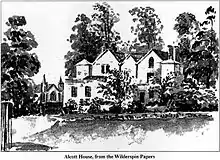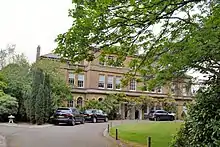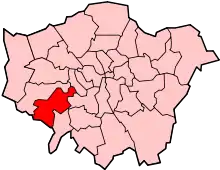Alcott House
Alcott House in Ham, Surrey (now in the London Borough of Richmond upon Thames), was the home of a utopian spiritual community and progressive school which lasted from 1838 to 1848.[1][2] Supporters of Alcott House, or the Concordium, were a key group involved in the formation of the Vegetarian Society in 1847.[3]

History and ideology
The prime mover behind the community was "sacred socialist" and mystic James Pierrepont Greaves, who was influenced by American transcendentalist Amos Bronson Alcott, and Swiss educational reformer Johann Heinrich Pestalozzi. Together with his followers, who included Charles Lane – and with the help of wealthy sponsors, Sophia and Georgiana Chichester – he founded Alcott House on Ham Common in Surrey in 1838. The Ham Common Concordium, as it came to be known, consisted of a working mixed cooperative community and a progressive school for children.
The community was dedicated to a regime of spiritual development and purification – in the words of Greaves, aiming to produce the "most loveful, intelligent and efficient conditions for divine progress in humanity". To this end the members submitted to an austere regime of early rising, strict vegetarianism (usually raw food), no stimulants, celibacy, and simple living, and experimented with various practices such as astrology, hydrotherapy, mesmerism and phrenology. The men grew their hair and beards long and wore loose fitting clothes, while the women defied convention by not wearing the traditional, restrictive corset.
Alcott House school was open to children from both inside and outside the community – the latter usually from radical parents who sympathised with its progressive educational stance. The curriculum emphasised moral education and the development of the child's innate spiritual gifts, teaching practical skills such as gardening and cookery as well as book learning. Punishment was frowned upon and education aimed to produce "integral men and women", able to live in a truly cooperative society and not simply playing traditional roles.
In 1848, the community came to an end and the house was purchased by John Minter Morgan to provide an orphanage,[4] though still run along vegetarian lines.

In 1856 the foundation stone was laid of a new building on the site, South Lodge, which exists to this day. The new building has been converted to flats and the grounds have been developed as Bishops Close.
See also
References
- "Latham, J.E.M. Search for a New Eden etc". (Review of J. E. M. Latham's book at findarticles.com)
- Twigg, Julia (1981). The vegetarian movement in England, 1847–1981: A study in the structure of its ideology. doctoral thesis. LSE. Retrieved 6 July 2020.
- Davis, John (28 July 2011). The Origins of the 'Vegetarians'. International Vegetarian Union. Retrieved 6 July 2020.
- Green, James; Greenwood, Silvia (1980). Ham and Petersham As It Was. Hendon Publishing. ISBN 0860670570. OCLC 16604168. Retrieved 6 July 2020. (number 18)
Sources
- The New Age, and Concordium Gazette (pub. W. Strange, 1845), the journal of the Ham Common Concordium
Further reading
- Frost, Thomas (1880). Forty Years' Recollections: Literary and Political. London: S. Low, Marston, Searle, and Rivington. pp. 40–52.
- Sanborn, F. B. (1908). Bronson Alcott at Alcott house, England, and Fruitlands, New England (1842–1844). The Torch Press.
- Latham, Jackie E. M. (1999). Search for a new Eden: James Pierrepont Greaves (1777–1842). Associated University Presses. ISBN 9780838638095. – especially chapter 11.
- Trahair, R. C. S. (30 June 1999). Utopias and Utopians: an historical dictionary. Greenwood Press. pp. 6–8. ISBN 978-0313294655.
